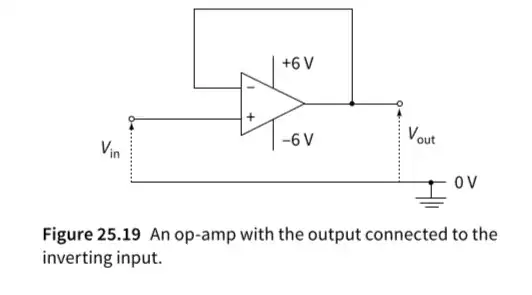The following is given as an example of a negative feedback loop in my textbook, note that the op amp is assumed to be ideal.
However I do not seem to get the logic behind this acting as a negative feedback loop, suppose if \$V_{in}\$ is \$0.01 \$ after passing through the op amp it should be amplified to \$+6\ \mathrm V\$.
Now \$V_{out}\$ is \$+6\ \mathrm V\$ hence the inverting input will also become \$+6\ \mathrm V\$ thus the difference between the two inputs becomes \$-5.99\ \mathrm V\$ thus \$V_{out}= -6\ \mathrm V\$ and this process shall repeat over and over again, would the circuit then just cycle between being \$+6\ \mathrm V\$ and \$-6\ \mathrm V\$ until the power supply is disconnected?
How is this considered a negative feedback, am I missing something crucial?

\$on EE.SE for inline MathJAX. 'V' for volt, 'A' for ampere, etc. SI standards recommends a space between the numbers and units just as you would for "5 apes" rather than "5apes". If you're using MathJAX as you have for your voltages then the norm is that variables are italicised and units are not. e.g.\$ U = +6 \ \mathrm V \$gives $ U = +6 \ \mathrm V $. – Transistor Apr 10 '21 at 16:05